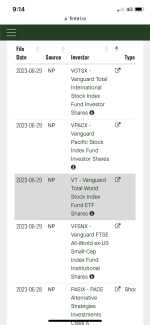Welcome aboard!
A new maybe next employee has been on board for two months.
And as far as I see he has far
more followers than any of his 'superiors', except of PVM.)
Read the congratulations/comments and recommendations. He seems to be a real talent.
Hopefully they can keep him and he stays on board.
"
Mujahir Abbasi
Machine Learning Intern at Brainchip | X-Data Scientist at Accenture Applied Intelligence
2w Edited
I am absolutely thrilled to announce that amidst these unprecedented times, I have been fortunate enough to receive summer internship offers from three incredible companies. After careful consideration, I am delighted to accept the opportunity to join Brainchip as a Machine Learning intern! Brainchip, a pioneering company specializing in Neuromorphic computing, has truly captured my passion for cutting-edge technology and artificial intelligence. Their commitment to pushing the boundaries of innovation aligns perfectly with my own aspirations in the field of machine learning. I am eager to contribute my skills and knowledge to their remarkable team and embark on an exciting journey of learning and growth. I want to thank my friends and family for their unwavering support. Your constant encouragement and belief in me have been my driving force. A special shout-out goes to Dr.
Eun-Young Elaine Kang,
Cambrian Sorel and
James Fukaye, MA, who went above and beyond to assist me in processing my application for the CPT. I would also like to extend my heartfelt appreciation to
Nandan Nayampally, Jon Gallegos,
Todd Vierra,
Nikunj Kotecha, and
Sheila Sabanal-Lau,MSHR,PHR for granting me this wonderful opportunity and guiding me throughout the process. I am truly honored to be joining your esteemed organization, and I am eager to contribute my skills and dedication to achieving our shared goals.
#machinelearning #intern #artificialintelligence #neuromorphic #neuralnetwork #edgecomputing #summerinternship California State University, Los Angeles"
https://www.linkedin.com/posts/mujahir-abbasi-80b13112a_machinelearning-intern-artificialintelligence-activity-7079659403754287104-u7OF
"Mujahir Abbasi
Machine Learning Intern at Brainchip | X-Data Scientist at Accenture Applied Intelligence
Los Angeles Metropolitan Area
6K followers 500+ connections
About
I am a Masters student at California State University, Los Angeles, previously worked at Accenture Applied Intelligence on identifying defects in GUMS in the production line using state-of-the-art Deep Learning algorithms. I was also responsible for setting up the data pipeline and building interactive PowerBI dashboards. Additionally, I have worked on building a Machine Learning based Demand Planning solution for a multinational consumer goods company.
I was engaged with a US based consumer intelligence company named Mobilewalla, where I worked on multidomain projects. Prior to Mobilewalla, I worked at Analytics and Insights group at
Tata Consultancy Services (
TCS_ India’s biggest software firm). At TCS, I was on a project of machine learning based sales demand forecasting for an European Retail giant. One of my main responsibilities was to deal with enormous amount of data using Big Data Technologies. Apart from this, I also worked on data engineering, data analysis as well as data modeling. Another instinct in TCS was with
TATA Digital (Tata Neu
*) where I implemented the dedupe logic for “
TATA SuperApp”.
At AIsee Technologies, I played a very important role for one of their government clients. I actively worked in the area of Deep Learning involving road traffic counting and classification for measuring the traffic volume.
Prior to AIsee Techonlogies, I worked at Tika Data and was involved in Automating Data Annotation Processes.
I have also worked for an educational startup on a tool which helped students in predicting the colleges in which there was maximum chances of getting selected based on their academic scores.
I have completed my graduation in Information Technology from a reputed university in India followed by a number of online courses in Machine Learning and Deep Learning.
Technology Expertise :- Machine Learning, Deep Learning, Artificial Intelligence, Computer Vision, Python, Azure Databricks, Azure Datalake Storage, AWS S3, AWS EMR, PySpark, MS-Excel, GitLab and Big Data.
Business Domains :- Retail, Advertisement, Consumer Goods, Government Organization and Education."
https://www.linkedin.com/in/mujahir-abbasi-80b13112a?trk=public_post_feed-actor-name
*https://en.wikipedia.org/wiki/Tata_Neu
and before

Data Science Analyst
Accenture Strategy & Consulting
Feb 2021 - Aug 2022
1 year 7 months
Bengaluru, Karnataka, India
his favourite is a Galton Board
not the original video as I don't know how to embed but the exact same board






